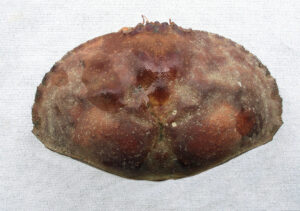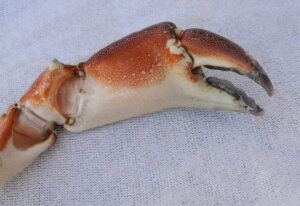Northern Lemon Rock Crab, Cancer johngarthi


 Northern Lemon Rock Crab, Cancer johngarthi. Crab provided by the commercial fishermen of the greater Los Cabos area, Baja California Sur, December 2011. Size: 10.3 cm (4.1 inches) x 6.5 cm (2.6 inches).
Northern Lemon Rock Crab, Cancer johngarthi. Crab provided by the commercial fishermen of the greater Los Cabos area, Baja California Sur, December 2011. Size: 10.3 cm (4.1 inches) x 6.5 cm (2.6 inches).
General information: The Northern Lemon Rock Crab, Cancer johngarthi, is a member of the Cancridae Family which includes the Rock Crabs many of which are favorite foods of humans which are known in Mexico as jaibas. In Mexico they are known as jaiba limón del norte.
Identification: The Northern Lemon Rock Crabs have wide, strongly oval shells that are paper thin and yellowish in color. The lower margin of the shell is straight. The anterior margins have wide rectangular teeth with granular edges that project slightly outside the general contour of the shell; the cracks between the teeth are poorly defined. The tips and borders of the claws are tipped in black. The carpus section of the claw has one tooth on the anterior dorsal side. The walking legs are long and slender without spines or setae. The Northern Lemon Rock Crabs reach a maximum of 14 cm (5.5 inches) in width.
Habitat and Range: The Northern Lemon Rock Crabs are found over sandy and mud bottoms at depths between 65 m (180 feet) and 630 m (1,600) feet preferring water temperatures of less than 15oC (59oF). They are found from Guerrero Negro south along the West Coast of the Baja and along the coast of the mainland south to Guatemala; they appear to be absent from the Sea of Cortez. They are a frequent bi-catch of deep water shrimp trawlers along the lower west coast of the Baja and have become commercially more important due to their size and the demand for crabs.
Diet: The Northern Lemon Rock Crabs are scavengers that feed primarily on other small invertebrates like snails and during their larval stage they can feed on microscopic organisms like plankton.
Conservation Status: The Northern Lemon Crab has not been formally evaluated from a conservation status. However, they are common and utilized as a human food and should be considered to be of Least Concern.